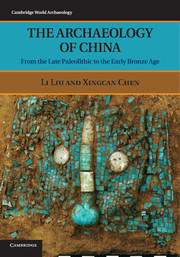Book contents
- Frontmatter
- Contents
- Illustrations
- Tables
- Preface
- Chapter 1 Chinese archaeology: Past, present, and future
- Chapter 2 Environment and ecology
- Chapter 3 Foragers and collectors in the Pleistocene-Holocene transition (24,000–9000 cal. BP)
- Chapter 4 Domestication of plants and animals
- Chapter 5 Neolithization: Sedentism and food production in the early Neolithic (7000–5000 BC)
- Chapter 6 Emergence of social inequality – The middle Neolithic (5000–3000 BC)
- Chapter 7 Rise and fall of early complex societies: The late neolithic (3000–2000 BC)
- Chapter 8 Formation of early states in the Central Plain: Erlitou and Erligang (1900/1800–1250 BC)
- Chapter 9 Bronze cultures of the northern frontiers and beyond during the early second millennium BC
- Chapter 10 The late shang dynasty and its neighbors (1250–1046 BC)
- Chapter 11 Chinese civilization in comparative perspective
- Appendix Horse bones in faunal assemblages from Neolithic and early Bronze Age sites in north China
- Glossary
- References
- Index
Chapter 5 - Neolithization: Sedentism and food production in the early Neolithic (7000–5000 BC)
Published online by Cambridge University Press: 05 June 2012
- Frontmatter
- Contents
- Illustrations
- Tables
- Preface
- Chapter 1 Chinese archaeology: Past, present, and future
- Chapter 2 Environment and ecology
- Chapter 3 Foragers and collectors in the Pleistocene-Holocene transition (24,000–9000 cal. BP)
- Chapter 4 Domestication of plants and animals
- Chapter 5 Neolithization: Sedentism and food production in the early Neolithic (7000–5000 BC)
- Chapter 6 Emergence of social inequality – The middle Neolithic (5000–3000 BC)
- Chapter 7 Rise and fall of early complex societies: The late neolithic (3000–2000 BC)
- Chapter 8 Formation of early states in the Central Plain: Erlitou and Erligang (1900/1800–1250 BC)
- Chapter 9 Bronze cultures of the northern frontiers and beyond during the early second millennium BC
- Chapter 10 The late shang dynasty and its neighbors (1250–1046 BC)
- Chapter 11 Chinese civilization in comparative perspective
- Appendix Horse bones in faunal assemblages from Neolithic and early Bronze Age sites in north China
- Glossary
- References
- Index
Summary
On the death of Baoxi, there arose Shennong (in his place). He fashioned wood to form the hoe, and bent or straightened wood to make the hoe-handle. The advantages of tilling and weeding were then taught to all under heaven.
Chapter, “The Great Treatise II,” in Book of Changes (ca. the ninth century BC), translated by James Legge (1879), modified“包牺氏没, 神农氏作, 斫木为耜, 揉木为耒, 耒耨之利, 以教天下,…” 《周易 · 系辞下》
The development of Neolithic cultures in China coincided with the arrival of the Mid-Holocene Climatic Optimum. The warm and wet climatic conditions enabled the flourishing of small villages in major river valleys, from the northeast to south China. These settlements’ archaeological remains are characterized by dwellings, storage pits, burials, and, sometimes, by ditched or walled enclosures. Domestication of plants and animals is clearly evident, and ritual activities are reflected in burials and on artifacts. Pottery vessels are prevalent. Polished stone tools increase in proportion, but chipped stones and microliths continue to be found. Grinding stones (slabs, handstones, mortars, and pestles) are common in toolkits. The mopan slabs and mobang elongate handstones, often occurring together in the archaeological context, now became a diagnostic tool complex in the toolkits, particularly in North and Northeast China.
- Type
- Chapter
- Information
- The Archaeology of ChinaFrom the Late Paleolithic to the Early Bronze Age, pp. 123 - 168Publisher: Cambridge University PressPrint publication year: 2012
- 1
- Cited by



